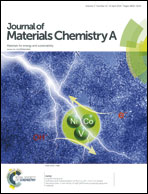High sulfur loading composite wrapped by 3D nitrogen-doped graphene as a cathode material for lithium–sulfur batteries†
Abstract
A porous three-dimensional nitrogen-doped graphene (3D-NG) was introduced as an interconnected framework for sulfur in lithium–sulfur batteries. The 3D-NG-sulfur composite (3D-NGS) with a high sulfur content of 87.6 wt% was synthesized via a facile one-pot solution method and sulfur was well dispersed within it. The as-designed 3D-NGS composite exhibits excellent rate capability and cyclability. The discharge specific capacity is 792 mA h g−1 after 145 cycles at a current density of 600 mA g−1 and the capacity fading rate is 0.05% per cycle. Even at a high rate of 1500 mA g−1, the composite still shows a good cycle performance with a capacity of 671 mA h g−1 after 200 cycles. The outstanding electrochemical performance can be attributed to the flexible porous 3D structure and N-doping in graphene. The flexible 3D-NG can provide a conductive framework for electron transport and alleviate the volume effect during cycling. N-doping can facilitate the penetration of Li ions across the graphene and restrain sulfur due to the strong chemical bonding between S and the nearby N atoms.


 Please wait while we load your content...
Please wait while we load your content...